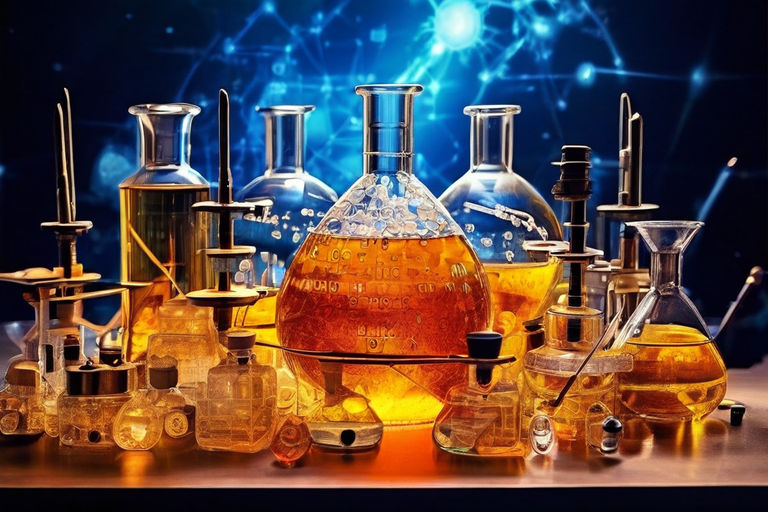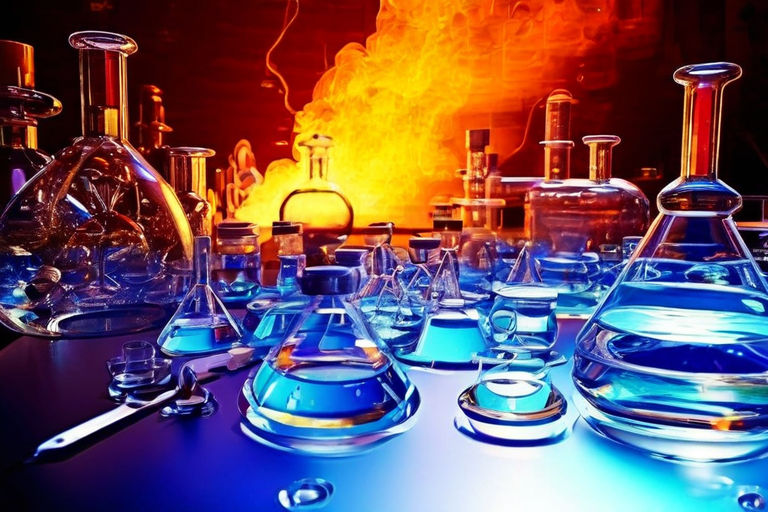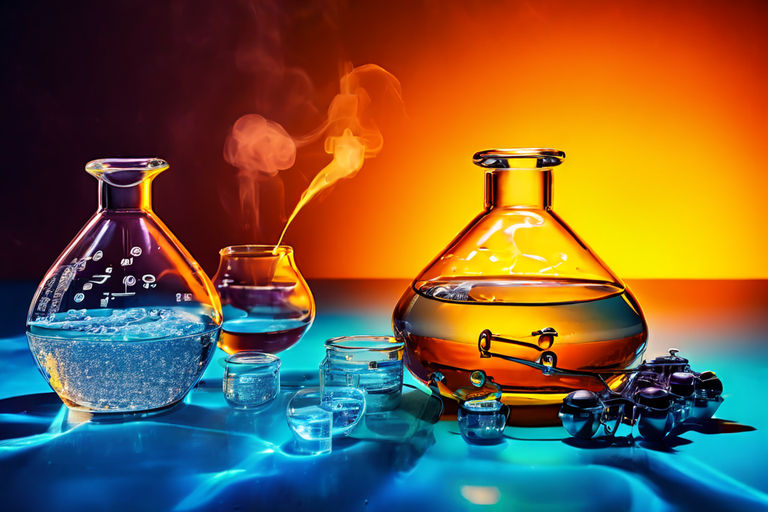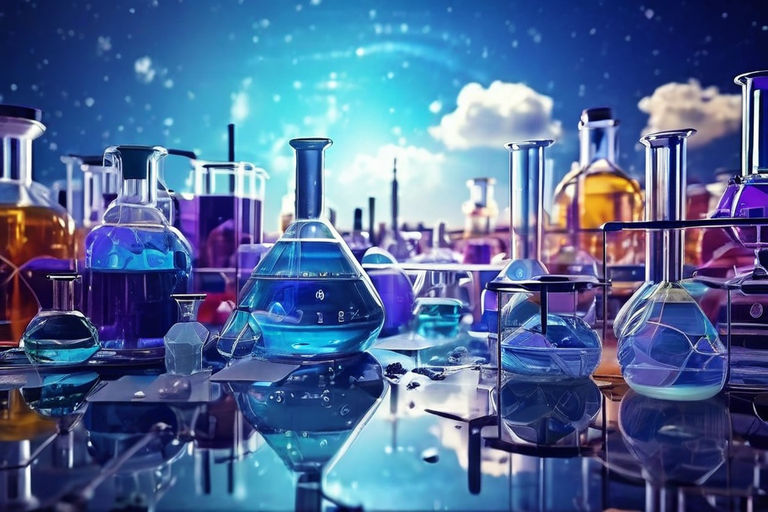Chemistry is the branch of science that studies matter, its properties, composition, structure, and the changes it undergoes during chemical reactions. It explores the fundamental building blocks of the universe, from atoms and molecules to complex substances, and seeks to understand how they interact and transform.
- Importance of Chemistry:
- What Does Chemistry Study?
- Chemistry Basics:
- Atoms in Chemistry:
- Elements in Chemistry:
- Chemical Reactions:
- Bonding in Chemistry:
- Molecules and Compounds:
- 1. Solid:
- 2. Liquid:
- 3. Gas:
- 1. Pharmaceutical Industry:
- 2. Materials Science:
- 3. Environmental Science:
- 4. Food Industry:
- 5. Agriculture:
- 6. Energy Industry:
- 7. Textile Industry:
- 8. Electronics Industry:
- 9. Cosmetics and Personal Care:
- 10. Automotive Industry:
- 11. Construction Industry:
- 12. Health and Medicine:
Importance of Chemistry:
Chemistry is of paramount importance for several reasons:
- Understanding Matter: Chemistry helps us comprehend the nature and behavior of matter, from the smallest particles to the most complex compounds, enabling us to manipulate and utilize materials effectively.
- Advancing Technology: Chemistry is central to technological advancements, driving innovation in fields such as electronics, materials science, and energy production.
- Improving Health: Chemistry plays a vital role in the development of pharmaceuticals, medical treatments, and diagnostic tools, contributing to advancements in healthcare.
- Environmental Protection: It aids in addressing environmental challenges like pollution and climate change, providing solutions for a sustainable future.
- Energy Solutions: Chemistry is crucial for developing renewable energy sources, optimizing energy production, and enhancing energy efficiency.
- Materials Development: Chemists create new materials with tailored properties for diverse applications, from aerospace to healthcare.
- Food and Agriculture: Chemistry ensures food safety, improves crop yields, and contributes to the development of better agricultural practices.
- Manufacturing and Industry: It optimizes industrial processes, leading to more efficient and sustainable manufacturing.
- Fundamental Research: Chemistry explores the fundamental principles governing matter, leading to unexpected discoveries and innovations.

What Does Chemistry Study?
Chemistry studies a wide range of topics, including:
- Atoms and Elements: It examines the properties and behavior of individual chemical elements, which are composed of atoms.
- Molecules and Compounds: Chemistry delves into the structure and properties of molecules, which are formed when atoms combine chemically to create compounds.
- Chemical Reactions: Chemistry investigates how substances interact and change during chemical reactions, which involve the breaking and forming of chemical bonds.
- States of Matter: It explores the behavior of matter in various states: solid, liquid, gas, and plasma, as well as other exotic states under extreme conditions.
- Thermodynamics: Chemistry deals with the study of energy and heat transfer in chemical processes, crucial for understanding reactions and energy-related applications.
- Kinetics: It examines the rates of chemical reactions and the factors that influence reaction rates.
- Quantum Mechanics: At the atomic and molecular level, chemistry relies on quantum mechanics to understand the behavior of particles and energy.
- Analytical Chemistry: This branch focuses on techniques and methods for identifying and quantifying substances in various samples.
Chemistry Basics:
Some fundamental concepts in chemistry include:
- Elements: These are substances composed of a single type of atom. The periodic table lists all known elements.
- Atoms: Atoms are the basic units of matter. They consist of a nucleus (containing protons and neutrons) surrounded by electrons.
- Molecules: Molecules are formed when two or more atoms chemically bond together. They can be simple (e.g., H2) or complex (e.g., DNA).
- Chemical Reactions: Chemical reactions involve the transformation of substances into new substances. Reactants are converted into products through chemical processes.
- Chemical Bonds: Atoms in molecules are held together by chemical bonds, including covalent, ionic, and metallic bonds.
- States of Matter: Matter can exist as a solid, liquid, gas, or plasma, depending on temperature and pressure conditions.
- Acids and Bases: Acids release hydrogen ions (H+) in solution, while bases release hydroxide ions (OH-). The pH scale measures acidity and alkalinity.
- Chemical Equations: These symbolic representations show the reactants and products of a chemical reaction, along with the stoichiometry (relative amounts) of each substance involved.
Chemistry provides a foundation for understanding the world around us, and its principles are integral to countless scientific and practical applications. It is a dynamic and ever-evolving field that continues to shape our lives and the future of technology, medicine, and sustainability.
Understanding atoms and elements is fundamental to grasping the foundation of chemistry.

Atoms in Chemistry:
Atoms are the smallest units of matter that retain the properties of an element. They are the building blocks of all chemical substances and play a crucial role in the structure and behavior of matter. Here are some key points about atoms:
- Structure: Atoms consist of a central nucleus composed of positively charged protons and electrically neutral neutrons. Electrons, which carry a negative charge, orbit the nucleus in energy levels or electron shells.
- Subatomic Particles:
- Protons: Positively charged particles found in the nucleus.
- Neutrons: Electrically neutral particles found in the nucleus.
- Electrons: Negatively charged particles found in electron shells around the nucleus.
- Atomic Number: The atomic number of an atom is the number of protons it contains. It determines the element to which the atom belongs. Atoms with the same atomic number belong to the same element.
- Isotopes: Isotopes are atoms of the same element with different numbers of neutrons. They have the same atomic number but different atomic masses.
Elements in Chemistry:
Elements are substances that consist of only one type of atom. They cannot be broken down into simpler substances by chemical means. The periodic table is a systematic arrangement of all known elements based on their atomic numbers and chemical properties. Here are some key points about elements:
- Chemical Symbols: Each element is represented by a chemical symbol, typically a one- or two-letter abbreviation. For example, “H” represents hydrogen, “O” represents oxygen, and “Fe” represents iron.
- Atomic Mass: The atomic mass of an element is the weighted average mass of all its naturally occurring isotopes. It is usually expressed in atomic mass units (amu) or unified atomic mass units (u).
- Properties: Elements exhibit unique chemical and physical properties. These properties are determined by the number and arrangement of electrons in their atoms.
- Groups and Periods: The periodic table is organized into vertical columns called groups and horizontal rows called periods. Elements within the same group share similar chemical properties, while those in the same period have a similar number of electron shells.
- Metals, Nonmetals, and Metalloids: Elements are classified as metals, nonmetals, or metalloids based on their properties. Metals are typically shiny, conductive, and malleable, while nonmetals are often non-conductive and have varied properties. Metalloids have characteristics of both metals and nonmetals.
- Chemical Reactivity: The arrangement of elements in the periodic table reflects their chemical reactivity. Elements on the left side (Group 1 and 2) tend to be highly reactive metals, while elements on the right side (Group 17 and 18) are nonmetals and noble gases, which are generally less reactive.
- Transuranium Elements: Elements with atomic numbers higher than uranium (atomic number 92) are synthetic and are known as transuranium elements. They are typically unstable and have short half-lives.
Understanding the structure and properties of atoms and elements is fundamental to understanding how chemicals interact, combine, and form the vast array of substances in the universe. The periodic table serves as a valuable tool for organizing and predicting the behavior of these elements, making it a cornerstone of chemical knowledge.
Chemical reactions, bonding, molecules, and compounds are central concepts in chemistry, essential for understanding how matter behaves and transforms.
Chemical Reactions:
Chemical reactions involve the transformation of one or more substances (reactants) into different substances (products) through the breaking and forming of chemical bonds. Several key aspects of chemical reactions include:
- Reactants and Products: Reactants are the starting substances, and products are the resulting substances in a chemical reaction.
- Chemical Equations: Chemical reactions are often represented using chemical equations, which show the reactants and products, along with the stoichiometry (relative amounts) of each substance involved.
- Balancing Equations: Balancing chemical equations ensures that the same number of each type of atom is present on both sides of the equation, obeying the law of conservation of mass.
- Types of Reactions: Chemical reactions can be classified into various types, including synthesis (combination), decomposition, single displacement, double displacement, and combustion reactions.

Bonding in Chemistry:
Chemical bonds are the forces that hold atoms together in molecules and compounds. The main types of chemical bonds are:
- Covalent Bonds: Covalent bonds occur when atoms share electrons. In a covalent bond, two or more atoms come together to achieve a more stable electron configuration.
- Ionic Bonds: Ionic bonds form when one atom transfers electrons to another, resulting in the formation of ions with opposite charges. The attraction between these ions holds them together in an ionic compound.
- Metallic Bonds: Metallic bonds are found in metals and involve a “sea” of electrons shared by all atoms in the metal lattice. This electron mobility gives metals their unique properties.
- Hydrogen Bonds: Hydrogen bonds are a special type of intermolecular bond that occurs when hydrogen atoms are attracted to highly electronegative atoms like oxygen, nitrogen, or fluorine in neighboring molecules.
- Van der Waals Forces: Van der Waals forces include dipole-dipole interactions and London dispersion forces. They are weak attractions between molecules and are responsible for phenomena like condensation and the properties of nonpolar molecules.
Molecules and Compounds:
Molecules are groups of atoms held together by chemical bonds. Compounds are substances composed of two or more different types of atoms chemically bonded together. Key points about molecules and compounds include:
- Molecular Formulas: Molecular formulas represent the types and numbers of atoms in a molecule. For example, H2O is the molecular formula for water, indicating two hydrogen atoms and one oxygen atom.
- Chemical Properties: The chemical properties of a molecule or compound are determined by the types and arrangement of its constituent atoms.
- Structural Formulas: Structural formulas provide more detailed information about the arrangement of atoms within a molecule, showing how atoms are connected.
- Ions in Compounds: In ionic compounds, positively charged ions (cations) and negatively charged ions (anions) combine to form neutral compounds.
Understanding bonding and molecules is crucial for predicting the behavior of substances in chemical reactions and for designing and synthesizing new compounds with desired properties. Chemical equations and the study of various types of bonds help chemists analyze, predict, and manipulate chemical reactions for practical applications in fields like pharmaceuticals, materials science, and environmental chemistry.
In chemistry, matter exists in three primary states: solid, liquid, and gas. Each state of matter has distinct properties that arise from the arrangement and behavior of particles at the atomic and molecular level.
1. Solid:
Solids have a fixed shape and volume. The particles in a solid are closely packed together and have strong attractive forces between them. Some key properties of solids include:
- Definite Shape: Solids maintain their shape and do not flow, making them rigid.
- Definite Volume: The volume of a solid is constant and does not change with external pressure or temperature.
- Low Compressibility: Solids are difficult to compress because their particles are already closely packed.
- High Density: Solids are generally dense due to their closely packed particles.
- Vibrational Motion: Although the particles in a solid do not change position, they vibrate in place due to thermal energy.
Examples of solids include ice (solid water), wood, metals, and minerals.
2. Liquid:
Liquids have a definite volume but take the shape of their container. The particles in a liquid are closer together than in gases but more spread out than in solids. Some key properties of liquids include:
- Indefinite Shape: Liquids take the shape of their container, allowing them to flow.
- Definite Volume: Like solids, liquids have a fixed volume that does not change with pressure or temperature.
- Moderate Compressibility: Liquids are more compressible than solids but less so than gases.
- Moderate Density: Liquids have a density between that of solids and gases.
- Random Motion: The particles in a liquid move freely but are attracted to each other, leading to random motion and surface tension.
Examples of liquids include water, oil, and alcohol.
3. Gas:
Gases have neither a definite shape nor a definite volume. They completely fill the container they are in, taking on its shape. The particles in a gas are widely spaced and have weak attractive forces between them. Some key properties of gases include:
- Indefinite Shape and Volume: Gases assume the shape and volume of their container, and they can expand to fill any available space.
- High Compressibility: Gases are highly compressible because of the large spaces between particles.
- Low Density: Gases are less dense than both solids and liquids.
- Random and Rapid Motion: Gas particles move freely and rapidly, colliding with each other and the container walls.
Examples of gases include oxygen, nitrogen, and carbon dioxide.
It’s important to note that matter can undergo phase transitions between these states. For example, as a substance is heated, it may change from a solid to a liquid (melting) and then from a liquid to a gas (vaporization). Conversely, cooling a gas can cause it to condense into a liquid and, at lower temperatures, freeze into a solid.
Understanding the properties and behavior of solids, liquids, and gases is crucial in various scientific disciplines and everyday applications, including chemistry, physics, engineering, and environmental science. These states of matter also play a central role in industrial processes, material science, and the study of phase changes.
Chemistry, often referred to as the “central science,” has strong interdisciplinary connections with various other scientific disciplines due to its fundamental role in understanding matter and its transformations. Here are some of the key branches of chemistry and their connections to other scientific fields:
- Biochemistry:
- Description: Biochemistry focuses on the chemical processes and substances that occur within living organisms.
- Interdisciplinary Connections: It bridges chemistry and biology, explaining the chemical basis of biological functions, such as metabolism, genetics, and cell processes.
- Applications: Biochemistry is crucial for understanding diseases, drug development, biotechnology, and the study of biomolecules like DNA, proteins, and enzymes.
- Physical Chemistry:
- Description: Physical chemistry combines principles of physics and chemistry to study the physical properties and behavior of matter, as well as the fundamental laws governing chemical reactions.
- Interdisciplinary Connections: It connects chemistry with physics, thermodynamics, quantum mechanics, and statistical mechanics.
- Applications: Physical chemistry is essential for understanding chemical kinetics, thermodynamics, spectroscopy, and the behavior of molecules and materials under different conditions.
- Organic Chemistry:
- Description: Organic chemistry is the study of carbon-containing compounds, focusing on the structure, synthesis, and reactions of organic molecules.
- Interdisciplinary Connections: It intersects with biology, medicine, and materials science, as many biological molecules and synthetic polymers are organic compounds.
- Applications: Organic chemistry is vital in pharmaceuticals, petrochemicals, plastics, and the development of new materials.
- Inorganic Chemistry:
- Description: Inorganic chemistry deals with compounds that do not contain carbon, including metals, minerals, and nonmetals.
- Interdisciplinary Connections: It is connected to materials science, geology, environmental science, and metallurgy.
- Applications: Inorganic chemistry is essential for developing catalysts, semiconductors, ceramics, and understanding the behavior of metals in various industrial processes.
- Analytical Chemistry:
- Description: Analytical chemistry focuses on methods and techniques for identifying, quantifying, and characterizing substances in various samples.
- Interdisciplinary Connections: It collaborates with biology, environmental science, and forensic science, providing tools for analyzing complex mixtures.
- Applications: Analytical chemistry is used in quality control, environmental monitoring, drug testing, and food safety, among other areas.
- Environmental Chemistry:
- Description: Environmental chemistry examines chemical processes in the environment, addressing issues like pollution, waste management, and the impact of human activities on ecosystems.
- Interdisciplinary Connections: It intersects with ecology, geology, and atmospheric science.
- Applications: Environmental chemistry contributes to sustainable practices, pollution control, and the preservation of natural resources.
- Materials Science:
- Description: Materials science explores the properties, structure, and behavior of materials, including metals, polymers, ceramics, and composites.
- Interdisciplinary Connections: It collaborates with physics, chemistry, engineering, and nanotechnology.
- Applications: Materials science is crucial for developing advanced materials for electronics, aerospace, energy storage, and medical devices.
- These branches of chemistry illustrate how chemistry serves as a bridge between various scientific disciplines. Its principles and methodologies are integral to advancements in medicine, technology, industry, and environmental conservation, making it a central science with far-reaching applications and interdisciplinary significance.
Chemistry has a profound impact on everyday life and a wide range of industries. Here are some of the key applications of chemistry in various aspects of our daily lives and industries:
1. Pharmaceutical Industry:
- Drug Discovery: Chemistry plays a critical role in the development of pharmaceuticals. Medicinal chemistry involves designing, synthesizing, and testing new drugs to treat various diseases and conditions.
- Formulation: Chemistry is used to create drug formulations that ensure the proper delivery of medications to the body.
2. Materials Science:
- Advanced Materials: Chemistry contributes to the development of advanced materials with tailored properties, such as lightweight alloys, superconductors, and high-performance polymers.
- Nanotechnology: Nanomaterials and nanotechnology, a branch of materials science, enable the creation of tiny devices and materials with unique properties, used in electronics, coatings, and medicine.
3. Environmental Science:
- Pollution Control: Chemistry is essential in analyzing and mitigating air and water pollution through techniques like water treatment and emission control.
- Green Chemistry: The field of green chemistry focuses on designing products and processes that minimize environmental impact and waste generation.
4. Food Industry:
- Food Safety: Chemistry is involved in ensuring food safety by detecting contaminants, preservatives, and additives using analytical techniques.
- Food Preservation: Chemistry contributes to the development of packaging materials and food preservation methods, such as canning and refrigeration.
5. Agriculture:
- Pesticides and Fertilizers: Chemistry is used to develop and analyze pesticides, herbicides, and fertilizers that improve crop yields and protect against pests and diseases.
6. Energy Industry:
- Renewable Energy: Chemistry is vital in the development of renewable energy technologies like solar cells, batteries, and fuel cells.
- Fossil Fuels: Chemistry plays a role in refining and processing fossil fuels, as well as in understanding combustion and emissions control.
7. Textile Industry:
- Dyeing and Finishing: Chemistry is used in dyeing textiles and creating finishes that enhance fabric properties, such as water repellency and flame resistance.
8. Electronics Industry:
- Semiconductors: Chemistry is integral to the production of semiconductor materials and the fabrication of integrated circuits used in electronic devices.
- Display Technology: Chemistry contributes to the development of displays like liquid crystal displays (LCDs) and organic light-emitting diodes (OLEDs).
9. Cosmetics and Personal Care:
- Formulation: Chemistry is involved in formulating cosmetics, skincare products, and perfumes to enhance their safety, stability, and efficacy.
10. Automotive Industry:
- Fuel Efficiency: Chemistry plays a role in developing more efficient fuels and catalysts for emission control in vehicles.
11. Construction Industry:
- Concrete and Cement: Chemistry is used in designing and improving the properties of construction materials like concrete and cement.
12. Health and Medicine:
- Diagnostic Testing: Chemistry is essential in diagnostic tests, such as blood chemistry analysis and medical imaging.
- Medical Devices: Chemistry contributes to the development of medical devices and imaging technologies.
These are just a few examples of how chemistry impacts our daily lives and a wide range of industries. Chemistry’s role in innovation and problem-solving is critical for addressing current and future challenges, including those related to health, energy, sustainability, and the environment.


